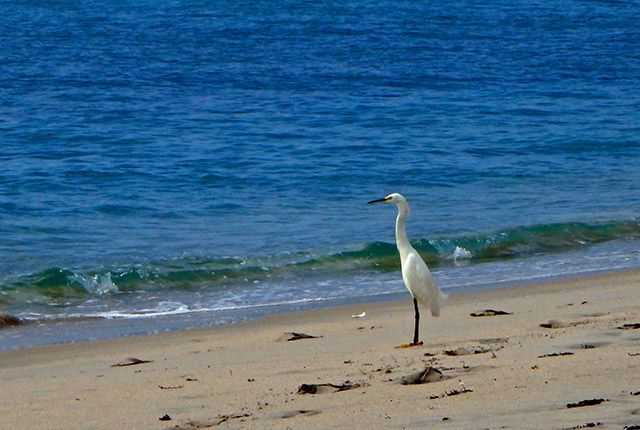
[dropcap]W[/dropcap]ading and diving birds are a constant sight out on the water. Successful offshore anglers know that scanning for birds can lead them to a sailfish or a school of dolphin. Unfortunately, inshore anglers often take birds and bird activity for granted. To add another element to your inshore game, start keeping an eye on the sky. Leave your safari hat and huge camera at home – you definitely don’t need to be an expert birder to understand how bird behavior can put you onto fish. Just lift your eyes from the water once in a while, and let our feathered friends reveal their clues.
Birds On the Flats
When fishing the flats, wading birds like herons and egrets can give up critical information about the water around you. First and foremost, during low-light conditions or when fishing an unfamiliar area, the presence of wading birds tells you a lot about water depth and terrain. Satellite imagery and GPS maps can give you a general feel for the layout of a network of flats, but sometimes, the overall scale of an area doesn’t translate well from a computer screen to a wide, featureless expanse of glassy water. Add to that the fact that flats and shoals can shift over time, and the value of wading birds as living navigational aids becomes apparent. The presence of wading birds will reveal the skinniest water around – the “crown” or ridge of the flat that is first to get exposed on a falling tide, and last to get covered up with incoming water. While you may pole onto a flat with a pretty good idea of where the crown is, wading birds can help confirm – or refine – your position. As an added bonus, a particularly heavy concentration of wading birds close to a shoreline or flat edge can hint at the presence of unseen predators herding baitfish into shallow water. Keep your eyes on big groups of wading birds, and make a move in their direction if you see any pushes, swirls, or tail tips. Remember that big reds, snook, and trout can crawl unseen through water that barely covers a heron’s knees! Wading birds aren’t your only friends on the flats. The passing shadow of an osprey or pelican can cause a hidden school of redfish or bonefish to briefly “hump up,” tipping an observant angler off to their location. Thankfully, passing shadows don’t seem to spook gamefish for long. These fish quickly settle down and get right back on the feed…with you hot on their tails.
Birds On the Beach
Beaches are another place where an eye to the sky can tremendously help your fishing. Whether running the beach by boat or hoofing it on foot, bird activity will often point you towards fish long before you see splashes and blowups. For shore-based anglers in the
Treasure Coast, a successful tactic is to drive from one beach access point to the next, quickly scanning for bird activity before continuing on. An inexpensive pair of binoculars really stretches your ability to see birds a good distance down the beach. Deeper-diving birds, like gannets or high-flying pelicans, can reveal deep bait schools that would otherwise be invisible to anglers. If fishing is slow on the beach, traveling birds can sometimes point you towards the action. When you see large flocks of pelicans or gulls moving down the beach with a purpose, it’s a pretty safe bet that there isn’t any nearby activity in the direction they’re coming from (birds definitely follow the “never leave fish to find fish” rule). Your next move should be in the same direction the birds are traveling – after all, you’re both looking for the same thing. While feeding birds are a sure sign that predators are nearby, resting birds can offer an observant angler a glimpse into the recent past. Flocks of pelicans floating just offshore are a good sign that you just missed some intense activity – activity that might boil back up at any second. Flocks of terns or gulls resting near the water’s edge are another good sign of recent gamefish activity. This is particularly true during late summer, when huge schools of anchovies (“glass minnows”) and tiny juvenile herring get pushed to shore by hungry predators. The activity can be so intense that countless tiny baitfish get washed up onto the sand, where they’re quickly scooped up by a squawking torrent of gulls and terns. In the predawn twilight, you’ll often hear this ruckus before you see it.
Birds are an angler’s eyes in the sky – constantly telling us a story. Learn to use them to your advantage! Make scanning for birds part of your regular routine, and you’ll start putting more fish in the boat. Not to mention, paying attention to herons and other wading birds might save you a lower unit – or at least a few embarrassing hours of waiting around for the tide to come back in.
Join us at the Florida Oceanographic Coastal Center in December to celebrate the birds of the Indian River Lagoon. Take a stroll down our beautiful mile-long nature trail and boardwalk to view wading birds hunting along the shoreline of the IRL. Keep your eyes open for tiny colorful warblers and soaring raptors that migrate through our area in the fall. For more information, visit www.floridaocean.org.
Zack Jud, Ph.D., is the Director of Education at Florida Oceanographic Society. He is a coastal ecologist (researching tarpon, snook, bonefish, permit, and lionfish), a marine science educator, and a fly casting and fly tying instructor. Zack can be reached at zjud@floridaocean.org